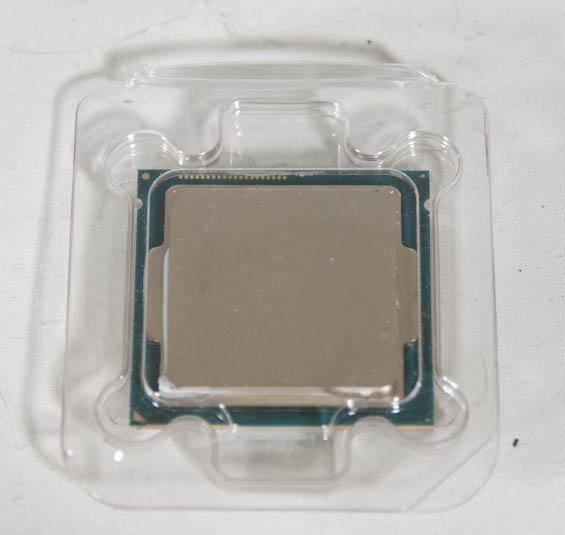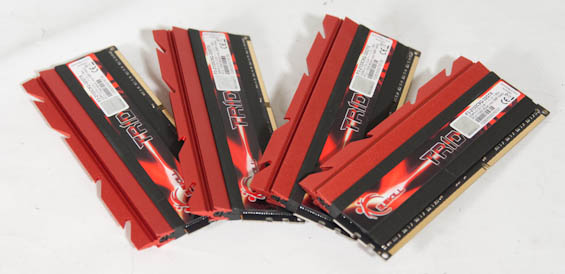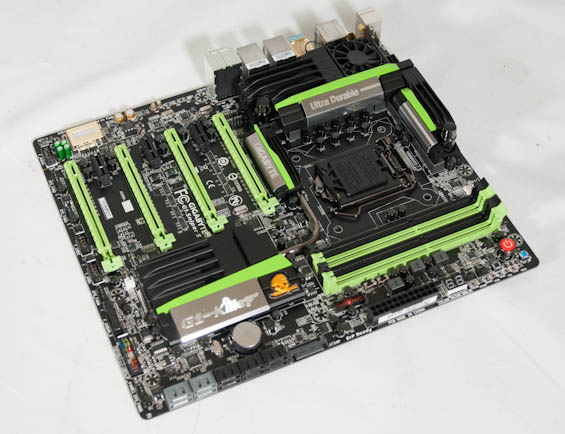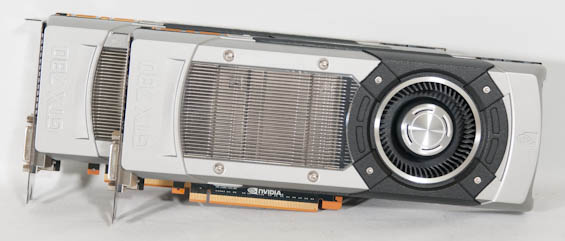The Neophyte's Custom Liquid Cooling Guide: How To, Why To, What To Expect
by Dustin Sklavos on September 30, 2013 12:01 AM ESTComponent selection for this build was tricky, but not overly so. If you're going to engage in an undertaking like this, you really do want to pick the most ideal hardware you can. Thankfully we had a few vendors willing to step up and donate some very high quality kit to this build.
Intel Core i7-4770K Processor

For our CPU we went with Intel's shiny new Haswell architecture in the form of the Core i7-4770K. This quad-core, hyper-threaded chip runs at a nominal 3.5GHz clock with a maximum turbo boost of 3.9GHz on a single core, and is one of Intel's first chips to feature an integrated VRM. Intel's 22nm chips seem to have been largely thermally limited, making the newest member of the family a compelling choice to be the center of a watercooling build. You do always run the risk of getting a dud CPU that simply doesn't want to run at a high clock speed without an unrealistic amount of voltage, though. Note that ours is a retail chip and not an Engineering Sample, so it's subject to the same potential limitations as any CPU you might pick up off the shelf.
Our thanks to CyberPowerPC for graciously donating this processor.
G.Skill Trident X 32GB (4x8GB) DDR3-2133 RAM

Our resident motherboard reviewer and overclocking expert, the good Dr. Ian Cutress, recommended we go with G.Skill for this build, and G.Skill was happy to oblige with a respectable kit of fast DDR3. This kit runs at a nominal 1600MHz, but features an XMP profile that sets it to run at 2133MHz with a CAS Latency of 9 at 1.6V. I'm not an aggressive memory overclocker, which makes the ready-out-of-the-box 2133MHz settings an easy way to score a little extra performance.
Our thanks to G.Skill for providing this memory.
Gigabyte G1.Sniper 5 Z87 Motherboard

I remain of the opinion that the Z87 chipset is arguably the most compelling part of Haswell, and Gigabyte's high end gaming offering hammers that home. The G1.Sniper 5 features a PLX switch enabling full PCIe 3.0 x16 lanes for each of two video cards, or PCIe 3.0 x8 for up to four. Alongside that are an additional four SATA 6Gbps ports to go along with the six that come with the Z87 chipset, dual gigabit ethernet NICs with one provided by Intel and the other courtesy of Killer Networks, and Creative Sound Core3D with a user upgradeable OP-AMP. There's even an 802.11n dual-band PCIe x1 wireless network adapter bundled with the motherboard.
But what sells this board for our purposes is that it includes not only active cooling on the motherboard's 16-phase power circuitry, but a liquid cooling path built in. There are barbs on both ends of the heatsink that allow you to include the power circuitry in your watercooling loop.
Our thanks to Gigabyte for providing this motherboard.
Dual NVIDIA GeForce GTX 780 Graphics Cards

With AMD currently still having issues with multi-GPU surround performance, we were left going to NVIDIA for a pair of high end graphics cards. Two GeForce GTX 770s would've been stellar on their own, but the 780 is getting a healthy reputation as being a decent overclocker in addition to just being a tremendously powerful card on its own. 7.1 billion transistors and 2,304 CUDA cores are nothing to sneeze at, and the 384-bit memory bus connected to 3GB of GDDR5 running at 6GHz stock ensures that beefy engine stays fed.
The biggest shame about using these reference 780s is actually having to remove their stock coolers. NVIDIA did a fantastic job engineering these shrouds, which are both very beautiful and very efficient.
Our thanks to NVIDIA for providing this pair of graphics cards.










106 Comments
View All Comments
C'DaleRider - Monday, September 30, 2013 - link
[q]...the HydrX PM is actually 90% distilled water (which contains no impurities) and a mixture of chemicals to prevent algae and corrosion. This is very similar to how coolant/anti-freeze works in your car; water carries heat very well, but is also corrosive, so chemicals are introduced into the mixture to counteract that effect.[/q]While the above is technically correct, the reasons auto manufacturers use glycol derivatives for coolant is because using dissimilar metals within a cooling system causes galvanic corrosion (in autos, aluminum radiators used, combined with the steel, iron and other metals in the cooling loop, causes a mild electrical charge to develop in the coolant, something glycol helps combat), something a water cooling loop(s) should not encounter given almost all radiators are copper/brass based as well as the cooling block(s) you'll use. Distilled water in and of itself isn't particularly corrosive when used in a cooling loop, as experience has shown by hundreds of people using pure distilled water. Go to XtremeSystems, for one place, and begin to read.
Another reason glycol is used is its ability to help raise the boiling point of water under pressure. Not exactly what you find in a computer water cooling loop....really doubt you see a 16psi pressure in a loop like you see in an automobile cooling system.
And, yes, I understand Swiftech will "void" their warranty on their products if not using their HydrX crap, but in reality, that cannot be enforced......the Magnuson–Moss Warranty Act, while primarily being directed at vehicles, could be successfully enforced in this instance, meaning Swiftech would have to provide the HydrX crap for free if required for their warranty to remain in effect. Otherwise, it'd be like Toyota or GM or Ford requiring the owner of one of their vehicles to only use the manufacturer branded oil to keep their vehicle's warranty intact, something that's illegal....and so is Swiftech's requirement to use HydrX to keep their cpu/gpu blocks and radiator warranties intact.
And those fans.....such fail. Get some GT's and leave that crap from Swiftech behind. Find out what low speed fans with real performance is all about.
Death666Angel - Monday, September 30, 2013 - link
"something a water cooling loop(s) should not encounter given almost all radiators are copper/brass based as well as the cooling block(s) you'll use."Yes, but I haven't heard of any detrimental effects using these chemicals, so why take the chance? And in any case, you'd need biocide anyway, this way you have a 2 in 1 solution.
DanNeely - Monday, September 30, 2013 - link
Something in the anti-freeze I used in the loop I setup when I built an LGA1366 box caused the tygon tubing to slowly break down and after about 4 years crack drowning my GPU in the process. When I took it apart I found the pins on my CPU block were completely clogged with tubing fragments (explaining the several C temp increase I'd been wondering about).Aikouka - Monday, September 30, 2013 - link
The usual reason given to not use an anti-corrosive agent in your loop is because it reduces the effective cooling potential since you're replacing water (what actually removes the heat) with an additive. Dustin stated that HydrX is 90% water, which means 10% is anti-corrosives, biocide and green dye. I mentioned in another comment that I use distilled water and two forms of biocide. The Dead Water biocide that I use is one drop per liter!So, why don't I worry about anti-corrosives? Because it's a custom loop and I know what went in it! I know that the actual flow portions of my loop are only made out of copper or brass (brass is copper + zinc). Some parts do use aluminum for construction purposes.
Adamantine - Monday, September 30, 2013 - link
Your article has a couple significant problems with the cooling setup. I understand some of it could be due to being given the parts free for review/article purposes, but I am going to ignore that for the most part and critique the article for improvements.First is the fans. While the fans provided will get the job done, there are basically two categories of fans, free air case fans and heatsink/radiator fans. Free air case fans perform terribly when mounted on an HS or rad due to a lack of static pressure (combination of fan blade design and fan motor). Of the radiator fans, the metric you want to use as the comparison tool is cfm per db ratio when mounted on a rad. When using this metric as the benchmark comparison, there are basically two groups of fans: Gentle Typhoons and everyone else. If you're using a fan controller (which is almost required), then the ideal model would most likely be the Scythe Gentle Typhoon AP45 (2150rpm). On my Lamptron FC5 fan controller the AP45's can get down to about 500/600 rpms or so. With 10 fans in push/pull (360+240 rad), switching from Scythe S-Flex (1900rpms) to the AP45, was about the equivalent of turning off 4 fans (one radiator) while at max speed. Higher rpm and still getting lower noise.
Second, fan orientation. You don’t mount the fans on the rads like you’re doing air cooling which takes into consideration balancing intakes vs exhaust and/or directing air flow path(s). All fans mounted on radiators, when doing an all internal cooling loop, need to be mounted as intakes unless you don’t care about cooling performance. If you don’t care about cooling performance, you shouldn’t be doing a water cooling setup in the first place as better cooling is the ENTIRE point. Radiator performance is directly affected by intake air temperature and any increase in intake temps will reduce radiator efficiency. All of the air being pushed inside the case will be forced out whatever exit is available and the highly unbalanced air pressure has a side effect of being able to give just enough air to most of the remaining components that might get warm. They’ll probably be a few degrees higher than pure air cooling with balanced air flow, but you’re not pure air cooling so it doesn’t really matter unless the components are hotter than what they are spec’d for, or if it affects the overclock and/or stability. At max fan speeds, probably not an issue.
You also picked a bad choice for a case. If it was the only one you had around, then I guess it’s what you HAVE to work with. However, you just recently reviewed the Phanteks Enthoo Primo. If you had to send it back, then this critique point isn’t that important. However, you could/should have mentioned that or why you choose the 540 over the Primo. The Primo, once it actually ships, will be THE best water cooling case on the market for the money (~$300 or less). Better than the venerable TJ07, Cosmos/Cosmos S, or newcomer 900D.
Some people probably think the water blocks are the most import parts in the loop, but in the current market, most of them perform fairly similar, so it’s probably more about looks, and radiator choice is more about what rpms you’re going to be running your Gentle Typhoons at. Pump choice is pretty much down to which (Rebranded) Laing model you’re going to use and how many.
superericla - Monday, September 30, 2013 - link
On a similar note, the orientation of the front radiator makes bleeding out air a pain. It's extremely likely that there's an air pocket in that radiator causing it to do almost none of the cooling if it wasn't bled properly. There is a lot I would have done very differently if I were the person writing this article, but years of water cooling experience in everything from a test bench to a CaseLabs case tends to help me with that.DanNeely - Monday, September 30, 2013 - link
An FYI for anyone thinking about installing a rad in that orientation. Either bleed the loop before installing the rad so it can sit flatish on the table (barb end higher), or unscrew the pump/res so you can tip the case on its front again putting the rad flat while rotating the pump/res combo enough to keep the res above it to assure inflow.cbgoding - Monday, September 30, 2013 - link
Since you covered fan orientation and speed, there's two other factors that make a great deal in improving noise levels:Decouple your pump. If the bottom of it touches the bottom of your case, it's going to hum. 2 Good methods to fix this are: hang it off of the top radiator or make a shoggy sandwich (google it) between the pump and the bottom of the case.
Fix your PWM settings. An mcp35x has its lowest speed at 20% PWM, and it's highest speed at 80%. To ensure that the pump never spins up at idle, set 50C as the low bounds at 20%, and have it on a linear scale to 75C at 100%.
Finally, regarding fans, if ball bearing noise is something that bothers you at low rpm, then yate loon d12sl12's at 5v or 7v are inaudible. They push less air than GT's, but if you have enough radiator, it doesn't matter.
cbgoding - Monday, September 30, 2013 - link
Oh, and if you do go the yate loon route, top off the sleeve bearings with lube, the factory isn't reliable about giving you enough. There's a good post on how to do that on overclockers.comDeath666Angel - Monday, September 30, 2013 - link
Wait, you want to regulate your pump depending on the (CPU, GPU or water) temperature? No one does that, that is absolutely useless. 60L/h flow rate have been shown to be enough, above that you get a maximum of a few K better cooling performance. I run my system at 85L/h because that is the ideal point of noise, below that and I get case resonance and above that and it is simply too loud on its own. I have tested it at max with 120L/h and saw no noticeable gains in cooling performance. Set you pump once and then let it be. Make sure you have a water thermometer and see if you can set your fan speeds according to temperature. But let your pump in peace. :P